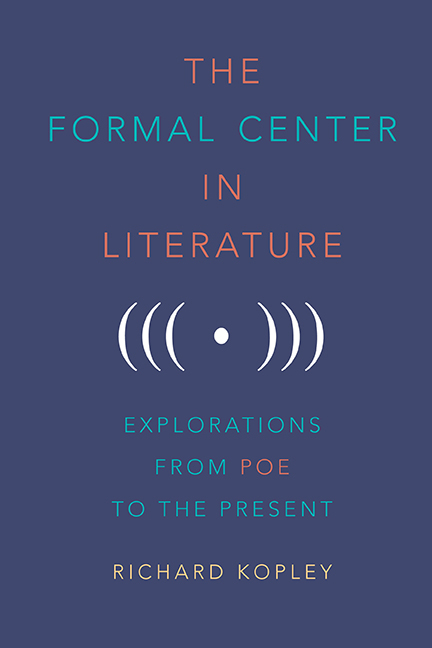Book contents
- Frontmatter
- Dedication
- Contents
- Acknowledgments
- Introduction
- 1 “Mournful and Never-Ending Remembrance” in Edgar Allan Poe's The Narrative of Arthur Gordon Pym
- 2 Retracing Our Steps in Edgar Allan Poe's “The Man of the Crowd”
- 3 “Scrutinizing the Parchment More Closely”: The Form of “The Gold-Bug” and Its Relationship to That of the Dupin Tales
- 4 Form and Reform in Nathaniel Hawthorne's “Earth's Holocaust”
- 5 The Circle and Its Center in Herman Melville's “Bartleby, the Scrivener”
- 6 Chiasmus in Henry David Thoreau's Walden
- 7 The Mythological Centers of Lewis Carroll's Alice Books
- 8 Table as Text in James Joyce's “The Dead”
- 9 The Structure of Sherwood Anderson's “Hands”
- 10 The Architecture of Ernest Hemingway's “The Three-Day Blow”
- 11 Balance in Dashiell Hammett's The Maltese Falcon
- 12 Framing Caesar in Raymond Chandler's The Big Sleep
- 13 The Ridge of the Domino in Patricia Highsmith's Strangers on a Train
- 14 The “X in the Air” in Joyce Carol Oates's “Where Are You Going, Where Have You Been?”
- 15 The Hybrid Center of Zadie Smith's White Teeth
- Notes
- Bibliography
- Index
10 - The Architecture of Ernest Hemingway's “The Three-Day Blow”
Published online by Cambridge University Press: 14 June 2019
- Frontmatter
- Dedication
- Contents
- Acknowledgments
- Introduction
- 1 “Mournful and Never-Ending Remembrance” in Edgar Allan Poe's The Narrative of Arthur Gordon Pym
- 2 Retracing Our Steps in Edgar Allan Poe's “The Man of the Crowd”
- 3 “Scrutinizing the Parchment More Closely”: The Form of “The Gold-Bug” and Its Relationship to That of the Dupin Tales
- 4 Form and Reform in Nathaniel Hawthorne's “Earth's Holocaust”
- 5 The Circle and Its Center in Herman Melville's “Bartleby, the Scrivener”
- 6 Chiasmus in Henry David Thoreau's Walden
- 7 The Mythological Centers of Lewis Carroll's Alice Books
- 8 Table as Text in James Joyce's “The Dead”
- 9 The Structure of Sherwood Anderson's “Hands”
- 10 The Architecture of Ernest Hemingway's “The Three-Day Blow”
- 11 Balance in Dashiell Hammett's The Maltese Falcon
- 12 Framing Caesar in Raymond Chandler's The Big Sleep
- 13 The Ridge of the Domino in Patricia Highsmith's Strangers on a Train
- 14 The “X in the Air” in Joyce Carol Oates's “Where Are You Going, Where Have You Been?”
- 15 The Hybrid Center of Zadie Smith's White Teeth
- Notes
- Bibliography
- Index
Summary
JAMES JOYCE and Sherwood Anderson lead inevitably to Ernest Hemingway. Of Anderson—who suggested, in Chicago, that the promising young writer go to Paris (and who provided letters of introduction)— Hemingway wrote, “I liked some of his short stories very much. They were simply written and sometimes beautifully written and he knew the people he was writing about and cared deeply for them.” Of Joyce, whom he met in Paris, Hemingway asserted, “I like him very much as a friend and think no one can write better technically. I learned much from him.” Certainly Hemingway knew Anderson's Winesburg, Ohio (1919) and Joyce's Dubliners (1914) when he wrote In Our Time (1925). He was then a rapidly developing writer, experimenting and learning his craft. Even as Joyce and Anderson were concerned with literary form, so, too, was Hemingway. He later came to comment about writing, in an often-quoted passage, “Prose is architecture, not interior decoration, and the Baroque is over.” We may investigate here the question of the architecture of one of the stories from In Our Time, “The Three-Day Blow.”
This seemingly informal story concerns Nick Adams and his friend Bill talking and drinking during a storm in northern Michigan—the work is based partly on Hemingway's experiences with Bill Smith in the fall of 1919. Nick has broken up with his girlfriend (as described in “The End of Something”) and is now regretful, wanting her back. This situation was drawn from young Hemingway's relationship with Marjorie Bump in 1919, but, given Nick's clear naiveté, “The Three- Day Blow” is actually set before World War I. Hemingway conflated several different times.
As we wonder about the possibility of symmetry here, we may be encouraged by the opening and the close of the story. In the beginning Nick finds an apple and puts it in his pocket—he doesn't eat it; he always has it. At the end, Nick is pleased to think about the possibility of going into town on Saturday night and returning to Marge: “It was a good thing to have in reserve” (49).
Certainly symmetry has been recognized as an essential element of some of the stories in In Our Time.
- Type
- Chapter
- Information
- The Formal Center in LiteratureExplorations from Poe to the Present, pp. 83 - 91Publisher: Boydell & BrewerPrint publication year: 2018



